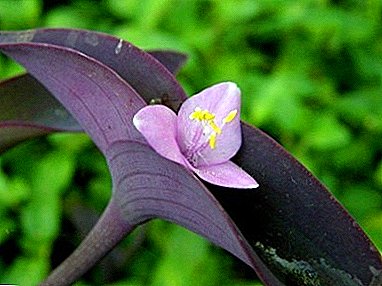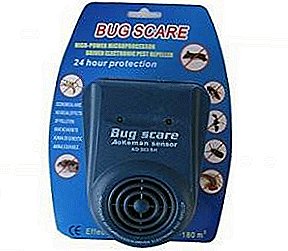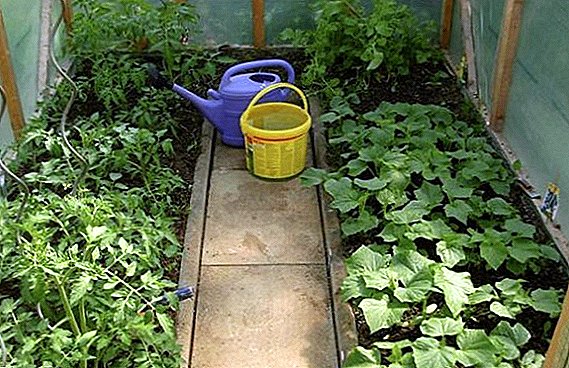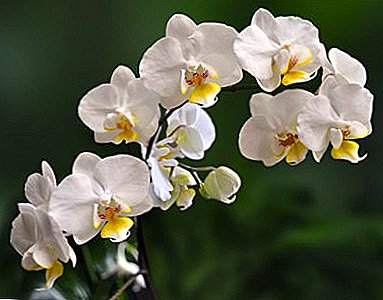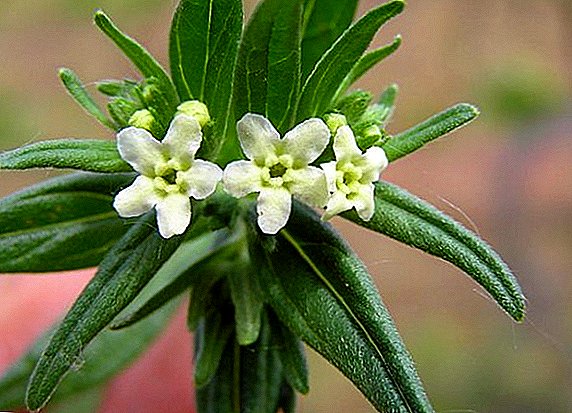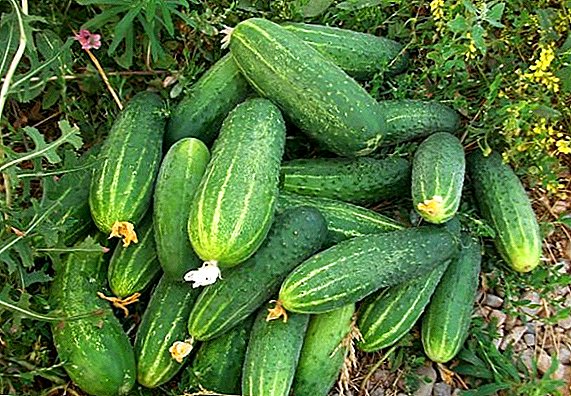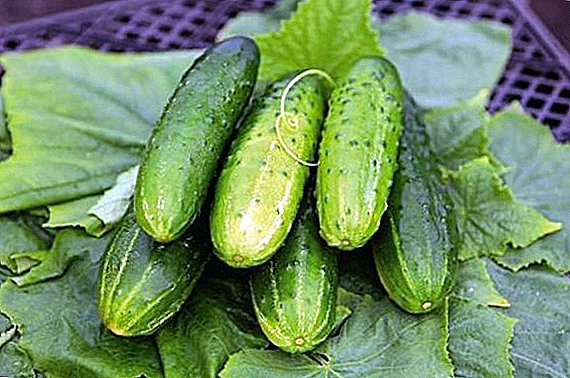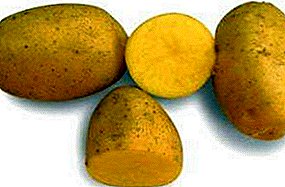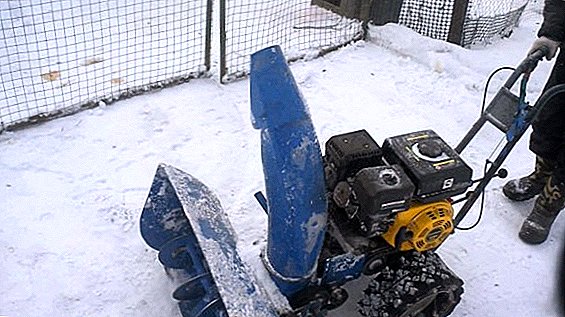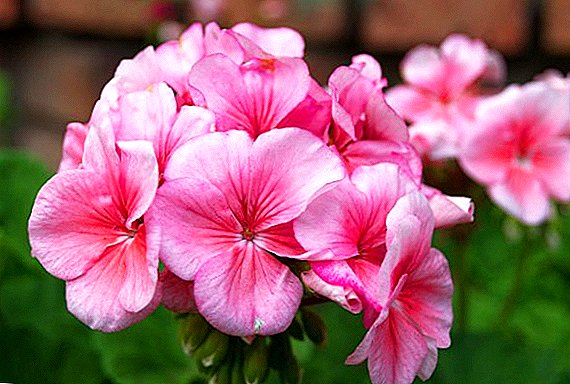 Geranium is a popular houseplant that grows well both in the apartment and on the street. Consider all the subtleties of growing geraniums at home, especially the care and measures to combat diseases and pests that can affect the plant.
Geranium is a popular houseplant that grows well both in the apartment and on the street. Consider all the subtleties of growing geraniums at home, especially the care and measures to combat diseases and pests that can affect the plant.
Optimum conditions for planting and growing plants
Geranium is a heat-loving and light-loving plant that prefers to grow on a southern window-sill. Normally, the plant will feel on the western and eastern sill, but the northern part of the house to accommodate the plant will not work.
The flower does not tolerate a lack of sunlight, the shoots are stretched, discolored, there is no flowering. When choosing a place for cultivation on the street, follow the same rules: choose a well-lit area, protected from drafts and strong wind.  A flower develops well when the air temperature in the room is at + 20 ... + 25 ° С, in winter the temperature should not fall below + 13 ° С, otherwise the flower will often hurt and may die. Too humid or dry air has a bad effect on the flower and provokes the appearance of pests or frequent diseases, so it is better to maintain humidity at the level of 50-60%.
A flower develops well when the air temperature in the room is at + 20 ... + 25 ° С, in winter the temperature should not fall below + 13 ° С, otherwise the flower will often hurt and may die. Too humid or dry air has a bad effect on the flower and provokes the appearance of pests or frequent diseases, so it is better to maintain humidity at the level of 50-60%.
Humidity of the soil should be moderate, too frequent watering can cause root rotting, rare - dry geranium, so watering should be carried out after the topsoil has dried out.
Did you know? "Geranium" from the Greek means "stork", it is believed that the name of the flower was due to fruits that look like a bird's beak.
How to plant a geranium
In order for a flower to develop well and be pleased with abundant flowering, it is necessary to follow the recommendations for planting a flower, so consider this information in more detail.
Landing dates
The timing of planting geraniums depends on the method of cultivation. If plant seeds are sown, then the best time for this is the end of May. Planted processes or rhizomes can be later - in the beginning or in the middle of June. Planting can also be carried out in a pot, in this case, the optimal time - January-February.
Preparatory work
The flower prefers to grow in loose, fertile and well-drained soil, the pH level can vary from acidic to neutral. A ready-made soil mixture especially for geranium, purchased in a specialized store, will also work well. If a special mixture was not found, you can prepare it yourself; to do this, mix any substrate for flowering plants (2 parts) with vermiculite (2 tablespoons per 1 l of substrate), washed with river sand (0.5 parts), peat ( 0.5 parts), perlite (1 tbsp. 1 liter of substrate).  It is recommended to decontaminate the soil in order to get rid of harmful bacteria and fungi. To do this, you can use a double boiler, placing the soil there for 30 minutes. Without a double boiler, you can steam the soil as follows: pour the substrate into a fabric bag, place it over a container with hot water, add boiling water to the liquid as the liquid cools down, cover the structure from above with a lid or thick cloth.
It is recommended to decontaminate the soil in order to get rid of harmful bacteria and fungi. To do this, you can use a double boiler, placing the soil there for 30 minutes. Without a double boiler, you can steam the soil as follows: pour the substrate into a fabric bag, place it over a container with hot water, add boiling water to the liquid as the liquid cools down, cover the structure from above with a lid or thick cloth.
It is very important to choose the right container for growing geraniums, so let's take a closer look at which pots you can plant a flower in. When choosing a pot, one should be guided not only by personal preferences, cheapness or ease of care for capacity, but also by the well-being of plants growing in pots made of different materials. Plastic containers are very convenient to use, they are easy to clean, do not fight, are cheap and practical, have a minimum weight.
Did you know? Geranium leaves exude a specific smell and in some Asian countries are very popular in cooking, they are used as a seasoning for the first and main dishes.
Geranium also feels fine in plastic pots, but sometimes it suffers from rotting of the roots, especially if there are not enough holes for water drainage or a minimal drainage layer is organized. The clay pot is considered the best option for growing a flower, since after watering, excess moisture can evaporate through the walls of the pot. In addition, the clay is able to pull out salts harmful for the plant from the soil. Clay containers provide good aeration of the roots, as they have a porous structure.
The size of the pot also matters, if you choose a large-diameter container for a small sprout or a young plant, you can provoke a lack of flowering. In large pots, geranium will intensively grow the root system, with which the ground part of the flower will grow faster. The best size for a geranium is a pot of 12-15 cm in diameter and 15 cm in height. 
Landing methods
Geranium is often confused with pelargonium, these plants have some external similarities and belong to the same genus, but are completely different colors. Pelargonium is grown only in apartment conditions, and geranium is a universal flower, therefore it grows well both in flowerbeds and in pots. Geranium can be planted in open ground in the same ways as in a pot, but with certain rules followed, so we will consider all the nuances of landing in each method in more detail.
Seeds
The seed method of planting geraniums on a flower bed is fairly common, the seeds have good germination and quickly germinate, which contributes to the good development of the ground part and the early flowering of young plants. The soil for planting geraniums should be already well warmed up, the temperature of the soil should be at least + 15 ° C. Plot well before digging, remove weeds. For sowing in the soil do shallow (up to 3 cm), long grooves.
Important! To preserve the seed, the sequence of processing with auxiliary agents must be observed, otherwise the seeds may lose their viability.
Before sowing, seeds are recommended to be discarded and processed, for this they are initially placed in a saline solution (2 tablespoons salt) per 1 l of water. Seeds that have surfaced — discarded, which have fallen to the bottom — can be used for sowing. Rejected seed washed under running water to get rid of salt residues, wipe with a paper towel.
Next, proceed to the disinfection with a solution of potassium permanganate: in 1 l of water dissolve the potassium permanganate at the tip of the knife to obtain a low-dose liquid. Immerse the seeds in the resulting solution for 20 minutes, then rinse under running water and dry with paper towel. The final stage is seed treatment with a growth stimulator.
For such processing, suitable "Zircon" or "Appin", which is recommended to use according to the instructions. The treated seeds are dried with a paper towel and placed on a sunny, warm window-sill, scattered on the newspaper for a day so that they dry well.
Sowing is done in prepared well-watered, warm water grooves, trying to keep a distance of 2 cm between the seeds. Sow crops with moist soil, do not tamp, you can lightly press the surface of the soil with your palm.
Video: planting geranium seeds
Scion
Planting geranium shoots that have taken root is an excellent option to quickly get a flowering plant. For reproduction of geranium shoots, it is necessary to use an adult plant with lateral branching. It is recommended to cut off the processes for further planting in open ground at the end of May, so that the formation of the root system takes place in well-heated ground.
The process of harvesting the appendix is as follows:
- Cut the selected process with a sharp knife (it must have at least 3 sheets), keeping the length of 7 cm.
- Leave the scion on the window sill for 3 hours to dry the cut place a little. Prevention of rotting of a geranium stem is the treatment of the cut site with crushed charcoal, which is carried out immediately after the process of cutting the process.
- The prepared shoot is planted in the pits in the garden (depth - 3 cm), tamping the soil around the stem.
- After planting, the soil around the appendix is watered with a small amount of warm water.
Video: geranium breeding process
Rhizome
Reproduction of geranium rhizome allows not only to get additional young plants, but also to rejuvenate old ones. The optimal time for such breeding is the end of summer, during this period the plant is at rest, and the procedure for dividing the root is tolerated easily by the plant.
You will be interested to know how to propagate the royal geranium at home.
To perform the procedure correctly, you must follow the sequence of actions:
- dig up an adult geranium, gently release the roots from the soil;
- carefully inspect the roots for damage, fungus, disease or pest damage. Sick, dry, affected areas remove;
- cut the geranium root into several parts so that each of them has at least one renewable growth point (young bud);
- On the prepared bed, it is necessary to dig small holes (their size depends on the volume of the root system of harvested roots), to fill each hole with a handful of peat and compost;
- install parts of the roots in the pit and fill the voids with the rest of the soil, lightly press the site with your palms and pour with warm water.

How to care for a plant after planting
High-quality care of plants - a pledge of good development and flowering, as well as the formation of resistance to disease, so consider how to properly care for geraniums growing in open ground. Watering geraniums is recommended to be artificially mechanized or sprinkled.
In the first case, watering is carried out manually by introducing a liquid under the root. Sprinkling involves the use of special nozzles for the formation of small droplets that simulate the loss of natural precipitation. It is necessary to water the flower as the topsoil dries out 1-2 times a week, provided there is no natural precipitation.
Important! If the rains are heavy and frequent - the plant is not recommended to be watered at all, so as not to provoke the development of rot on the roots.
For the first feeding of the geranium, any nutrient solutions for flowering plants that contain a sufficient amount of phosphorus will do. A similar top dressing is introduced before flowering to stimulate the formation of a large number of lush buds. The introduction of nutrient solutions carried out according to the instructions on the package. During the formation of inflorescences it is recommended to make potash supplements for flowering plants according to the instructions.
Pest and disease control methods
Outdoor geraniums are more likely to suffer from diseases and pests than a houseplant, so consider whether it is possible to prevent the defeat of a flower, and how to do it.
Common geranium diseases include:
- powdery mildew - fungal disease, which manifests itself in the form of white plaque on the leaves, over time, absorbing the entire terrestrial part of the plant. Intensive development of the problem occurs with regular high humidity of the soil and air, together with high temperature. Treatment of the disease occurs by treating the plant with colloidal sulfur or copper sulfate according to the instructions. It is possible to prevent the disease by carrying out preventive measures in the form of compliance with recommendations for irrigation, removal of plant residues from the site;
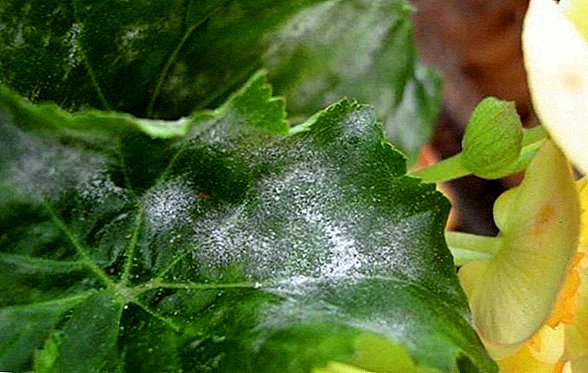
- root rot - A fungal disease that affects the root system. The main signs of a lesion are yellowing of the leaf plates and their wilting. White scurf appears on the stems, which soon darkens, the plant dies. Root rot treatment often fails to protect the plant, usually resorting to prevention. Preventive measures should consist of regularly loosening the soil in the flower bed, observing the irrigation regime, and treating the plant with Fundazol according to the instructions;
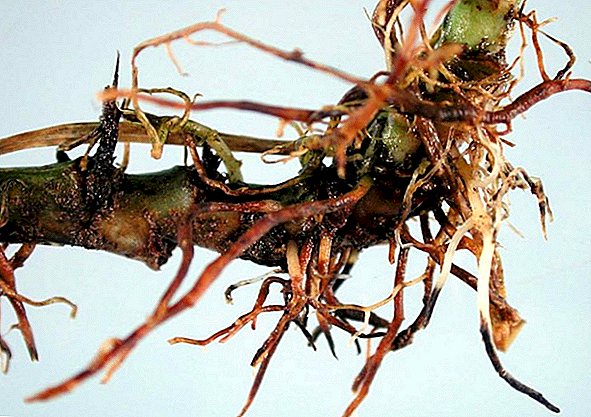
- black leg - A fungal disease that affects the stem of a plant at the root. The disease develops due to poor soil aeration, frequent watering and cool temperatures. It is impossible to cure the affected plant, but it is possible to timely cut healthy processes for subsequent rooting. For the prevention of disease follow the recommendations for irrigation, regularly carry out weeding of the soil, grow geraniums on light soil;
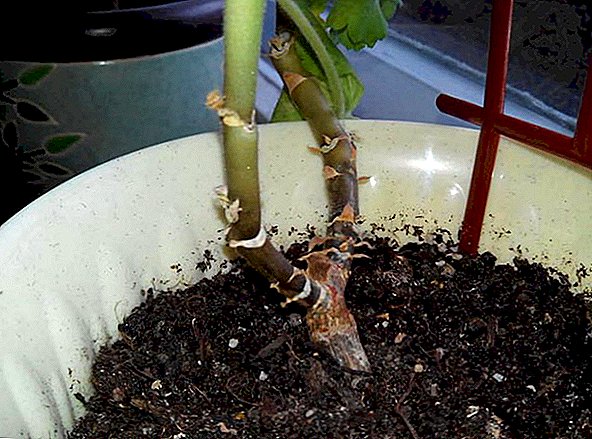
- bacterial rot - The causative agent of the disease are bacteria that infect leaf sheets (they become covered with dry spots and become deformed). Bacterial rot is incurable, but preventive measures have a good effect: observance of precautionary measures during planting (using clean tools), timely destruction of plant residues and pest control.
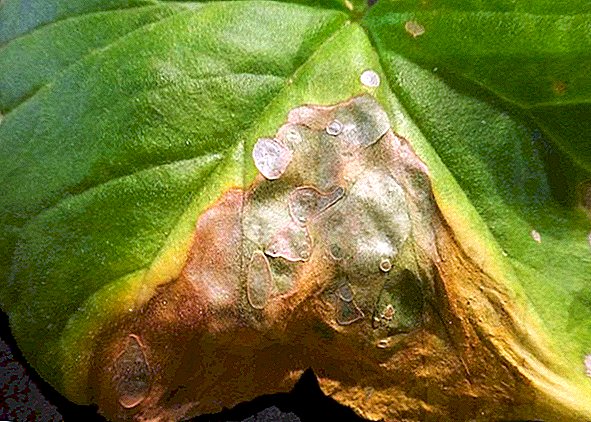
Among the pests that can infect geranium, emit:
- ticks - small insects that attack the ground part of the plant, sucking the juice from the leaves and stems. Geranium leaves when ticked are covered with small black dots, begin to curl and wither. It is necessary to fight the pest with the preparations "Fitoverm", "Aktellik" according to the instructions;
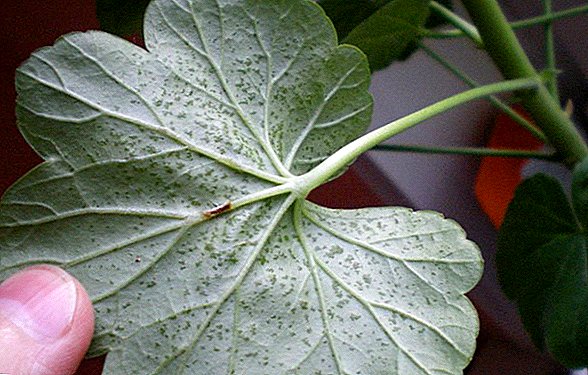
- thrips - small bright insects with a long body, whose vital activity provokes deformation of the ground part of the plant. Growths appear on the back of the sheets, the edges of the flowers turn brown. Fight against thrips should be carried out "Konfidor" or "Fitoverm" according to the instructions;
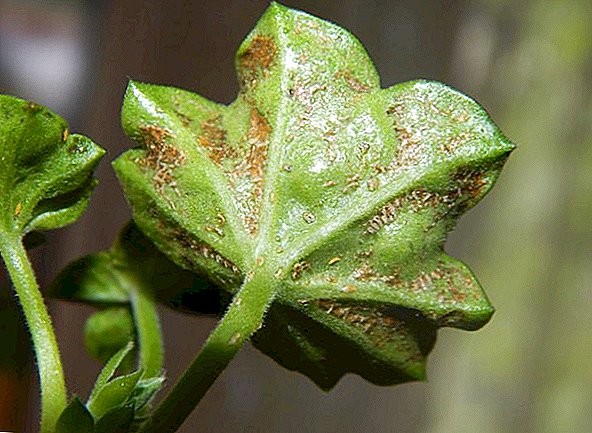
- aphid - small green insects that provoke yellowing and twisting of leaf plates. In order to destroy the pests, it is necessary to remove the most affected parts of the plant along with the colonies of aphids. Spray the plant with Iskra or Aktellik according to the instructions;
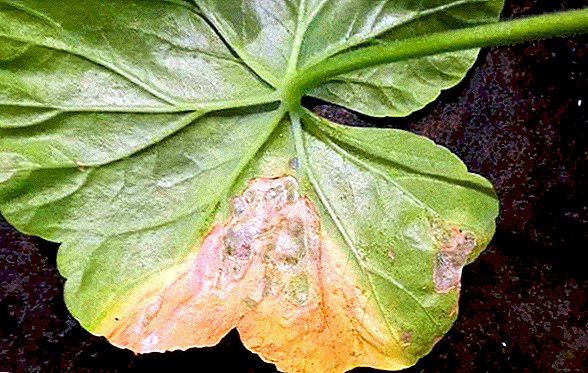
- mealybug - A small-sized pest that is masked by a white sticky substance that looks like cotton. The pest control is carried out with Aktellk and Aktara preparations according to the instructions.

Thus, planting geraniums can be carried out in a pot or an open ground in different ways, the features of the landing and the timing of the procedure differ depending on the method. In order to grow a healthy and strong flowering plant, it is necessary to comply with all the recommendations for the care and timely deal with diseases and pests.










